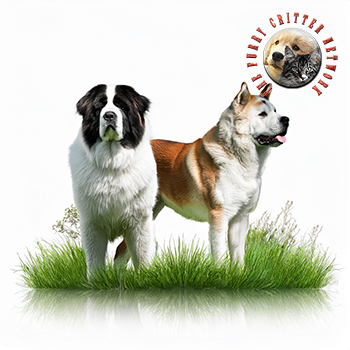Behavior
This robust, vigorous, very courageous dog is independent and proud but calm. He is docile making him an excellent pet that is easy to live with. This exceptional guard dog is wary of strangers and always on the alert, but he rarely barks. The Akita has an alpha personality, and therefore has difficulty living with other dogs. Firm though gentle training is required.
Although the American Kennel Club has put the Akita in the Working Group, several different breeds contributed to the modern Akita, some hunting dogs and some dogs used as competitive fighting dogs; however, it must be made clear that the common 'Japanese Fighting Dog' moniker is inaccurate. While the Akita's ancestry may lie with dogs used for fighting the modern day Akita is a long way from this and indeed most good breeders will not breed from dogs that are known to have aggressive natures. In general the Akita is very laid back, and has an easy-going temperament which makes it a very good family environment pet.
Akitas are a large breed, not a giant breed. They are excellent house dogs. They require only a moderate amount of exercise. Akitas are known to be very quiet dogs, only barking "when there is something to bark about". The two most outstanding characteristics of the Akita as a house pet are that they are very clean and that they are very easy to house break. Akitas have been described as almost "cat-like," as they are clean and odorless. This may also be one of the reasons why they housebreak so easily. Most Akitas respond so well to housebreaking that they are trained in a matter of weeks, although it may take longer if other "slower learning" dogs are present.
As far as the family children are concerned, there are few worries. Akitas are devoted, patient friends and protectors of children. Akitas are typically very gentle with children, and it is said that Japanese mothers often left their children with only the Akitas to watch over and protect them. Remember, however, that young children should never be left unattended with a pet. And while an Akita may love "his" children, he will not necessarily love their friends, especially when they run around the yard and scream. When raised indoors with children, they can be excellent companions. Left unattended in the backyard or in a kennel, they tend to develop "personality" problems and become very destructive to the yard, which is due to boredom. They are highly pack oriented, thus, isolating them from the pack (i.e., the owner) causes them great stress. Akitas tend to be stubborn and require a firm but loving education where "no" always means "no" and never "whatever".
The Akita is a dominant dog who may expect other dogs to be submissive. If they fail to live up to the Akita's expectations, incidents can happen. Akitas have a high and well-developed prey drive, particularly to small animals, including cats. An Akita is not likely to shower affection on someone that is not a member of his family or a close friend that he sees frequently, and can be extremely aloof. Akitas properly socialized and raised with other animals usually accept them as members of the family. The loyalty and devotion displayed by an Akita is phenomenal. The typical pet Akita will follow you from room to room, yet has the uncanny ability not to be underfoot. Your Akita lives his life as if his only purpose is to protect you and spend time with you. Akitas may, however, have a tendency to be very aggressive to other dogs and small animals and have a strong prey drive. It is not uncommon for an Akita to catch and kill small (or even large) animals (including cats, guinea pigs, rabbits and small dogs) if it is allowed to wander and should therefore never be allowed to run off its lead around other animals.
Health
Akitas in UK and USA/Canada surveys had a median lifespan of about 10 years, which is similar to other breeds of their size. In a 2004 UK Kennel Club survey, the most common causes of death were cancer (32%), cardiac (14%), and gastrointestinal, including bloat/torsion (14%). In a 2000-2001 USA/Canada Health Survey, the most common causes of death were cancer (21%), GDV (=bloat/torsion, 21%), musculoskeletal (15.5%), and autoimmune (7%).
Some of the health conditions known to affect this breed include:
- Canine herpesvirus, a strain of the Herpes virus that happens to affect canines
- Gastric dilatation volvulus (GDV), a condition associated with bloat;
- Pemphigus, which causes the autoimmune system to attack the dog's skin (leading to pustules)
- Progressive retinal atrophy (PRA), an adult-onset condition which gradual degeneration in the eye cells (i.e. rods and cones)
- UveoDermatological Syndrome (UDS), known as Vogt-Koyanagi-Harada (VKH) disease in humans
- Sebaceous adenitis, an autoimmune condition which attacks and destroys the dog's sebaceous glands
- Canine Hip Dysplasia
- Hypothyroidism
- Gastric Dilatation Volvulus (GDV = "Bloat" or "Torsion") Akita owners should take special note of the high incidence of GDV (Gastric dilatation volvulus) in this breed. Excess gas trapped in the dog's stomach causes "bloat". Twisting of the stomach (volvulus or "torsion") causes or is caused by excess gas. GDV is an emergency condition requiring immediate veterinary treatment. Akita owners should be alert to the symptoms of GDV and know the location of the nearest emergency veterinary facility.






